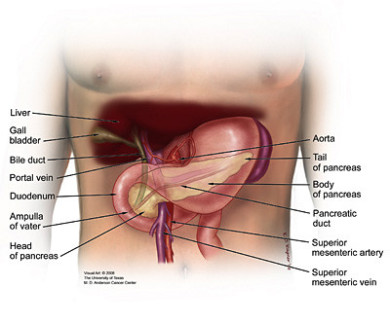Pancreatic Cancer Information
WHAT IS THE PANCREAS?
The pancreas is a gland, about six inches long, located in the abdomen. It is shaped like a flat pear and is surrounded by the stomach, small intestine, liver, spleen and gallbladder. The wide end of
the pancreas on the right side of the body is called the head. The middle sections are the neck and body. The thin end of the pancreas on the left side of the body is called the tail. The uncinate
process is the part of the gland that bends backwards and underneath the head of the pancreas. Two very important blood vessels, the superior mesenteric artery and superior mesenteric vein, cross
behind the neck of the pancreas and in front of the uncinate process.
The pancreas is both an exocrine gland and endocrine gland. Exocrine cells of the pancreas produce enzymes that help with digestion. When food enters the stomach, exocrine cells release the
pancreatic enzymes into a system of small ducts that lead to the main pancreatic duct. The pancreatic duct runs the length of the pancreas and carries pancreatic enzymes and other secretions,
collectively called pancreatic juice. The common bile duct runs from the gallbladder behind the head of the pancreas and carries bile. These two ducts join and empty into the first portion of the
small intestine called the duodenum. The point where these two ducts connect with the duodenum is called the ampulla of Vater. When the enzymes enter the duodenum, they meet the food emptied by the
stomach and aid in the digestion of fats, carbohydrates and proteins.
For more information on Pancreatic Cancer than we have provided please visit PanCan.org




